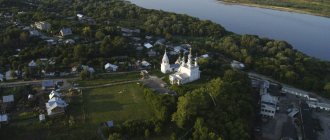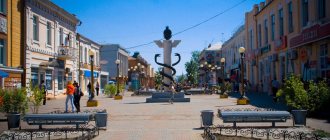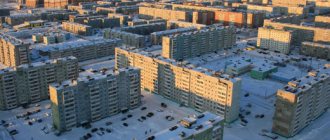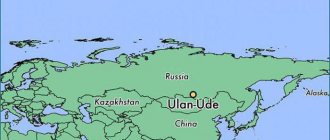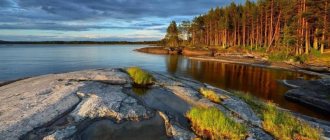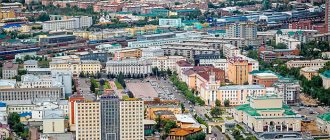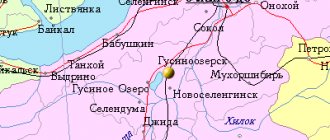On the eastern coast of Lake Baikal is the city of Ulan-Ude, the capital of the Republic of Buryatia. With the development of the tourism industry, more and more of our fellow citizens can show the location of Ulan-Ude on a map of Russia. Many tourists flock to the city from different parts of the country, including many foreigners. Most of all guests of this place are attracted by:
- Buddhist culture.
- Traditions of the Buryat people.
- Settlements of the Old Believers.
- There are many tours along the shores of Lake Baikal, of which start from Ulan-Ude.
- Tours to Khamar-Daban - a mountain range in the south of Eastern Siberia in the southern Baikal region, most of which is located in Buryatia.
By the way, the largest sculptural statue of V.I. Lenin’s head in the world was installed in Ulan-Ude; its weight is 42 tons. The huge sculpture was installed in 1970, when the country celebrated the 100th anniversary of the leader's birth.
This city also has its own sporting preferences. Mini-football is the most popular among team sports. In the capital of Buryatia, mini-football competitions are held; not only Russian teams come here, but also athletes from Mongolia and China.
Amazing fact. What can the Buryats have in common with the Chileans, because it seems that the cultures are in no way similar. It turns out that Ulan-Ude and the Chilean city of Puerto Natales are antipodean cities. This means that these two places are located at points on the earth's surface diametrically opposite to each other. There are 12 pairs of antipodal cities in total, and one of these pairs is Ulan-Ude and Puerto Natales. Not everyone knows that there are datsans not only in Tibet, but also in Russia. In Buryat culture, a datsan is a Buddhist monastery - a university. Outstanding Buryat datsans:
1. Ivolginsky datsan “KhambynSume” is the center of Russian Buddhism. It stands in the steppe thirty kilometers from the capital of the Republic. The residence of the lama, the head of the Buddhists of Russia, is also located here. The complex of the spiritual center includes:
Ivolginsky datsan
- main cathedral church.
- Small wooden temple.
- Choira Faculty of Philosophy.
- Greenhouse for the Bodhi tree. Such trees are specially cultivated and planted in Buddhist monasteries. It was under the Bodhi tree that Prince Gautama, who became Buddha, achieved enlightenment. The Buddhist Institute of the Ivolginsky Datsan has the status of a university; future lamas are trained here. The monks of the monastery treat parishioners with Tibetan medicines. Tourists and pilgrims flock here from all over the world.
The incorrupt body of Dashi-Dorzho Itigelov, considered one of the main relics of Buddhism, is preserved in the Ivolginsky datsan. Entrance to the temple is open from 9 am to 7 pm.
2. The Buryat region is also known for the Atsagat datsan. Peace and harmony always reign here.
3. Datsan Rinpoche Bagsha has existed since 2004, and was built with the blessing of the Dalai Lama. This datsan houses the largest Buddha statue and the largest Buddhist bell in the country.
Datsan Rinpoche-bagsha
Sights of Ulan-Ude
The Republic of Buryatia is famous for its hospitality. But if Russians express their joy at the arrival of guests with bread and salt, then Buryats demonstrate hospitality with the help of a hadak scarf. This is a long Buddhist scarf that is considered a universal gift for any occasion. And expressing friendliness and hospitality on behalf of all residents of the Republic, the monument “Mother of Buryatia” greets everyone with a hadak in their hands. For many, this monument evokes associations with the American Statue of Liberty, which only adds to the popularity of the Buryat capital. Interestingly, the height of the pedestal is 8 meters and the monument itself also rises 8 meters.
All natural history lovers should definitely visit the Geological Museum. Everything that the subsoil of the land of Buryatia preserves in itself is collected here: stones, minerals, metals. The lands of this region contain almost the entire periodic table. The museum also displays samples of fossil flora, fauna, paintings by geological painters, ancient maps, and other exhibits. Visiting the museum is free. Nearby, in a shop you can buy national-style jewelry made from local precious and semi-precious stones.
Art lovers would like to know where the theater is located in Ulan-Ude? The Opera and Ballet Theater is located on Theater Square. The architecture of the theater building is a separate matter; it amazes with its sophistication and originality. Near the theater there are: the sculpture “Beauty of the Angara”, a light and music fountain, flower beds, and benches.
sculpture "Beauty of the Angara"
Tour guides around Ulan-Ude often ask tourists: what detail unites the capital of Buryatia with Paris? The answer is very simple: the Arc de Triomphe. This landmark was erected in 1891 in honor of the arrival of the Tsarevich of the Russian Empire in the city of Verkhneudinsk (as Ulan-Ude was called in those days). During the communist regime, the arch was destroyed, but in 2006 it was rebuilt, carefully observing historical accuracy.
If you ask any city resident which direction Arbat is located, then, without being at all surprised, the Ulaninite will wave towards the pedestrian part of Lenin Street. Yes, there is an Arbat here. Guests and residents of the city love to stroll here. The most remarkable places of the local Arbat include:
- Sculpture "The Rod of Mercury and the Horn of Plenty."
- Fountain "Fish".
- house of merchant N.L. Kapelman, built at the beginning of the 20th century. The building is decorated with snow-white columns and impressive sculptures of Atlanteans.
- Monument to the famous Russian writer A.P. Chekhov. It is no coincidence that it is located in the capital of Buryatia; the fact is that Anton Pavlovich always spoke very highly of these places. For this, the grateful Buryats erected a monument to him in the style of urban sculpture.
- Museum of the History of Ulan-Ude, where a variety of Buryat household items are presented - spinning wheels, samovars, furniture.
- The sculptural composition “Two Birds” symbolizes love and respect for nature.
Museum of History of Ulan-Ude
Flag
The flag of Ulan-Ude is a rectangular panel with a height to length ratio of 2:3, consisting of two vertical stripes - blue (at the hoist 2/9 of the length of the panel) and yellow; at the top of the blue stripe there is a yellow circle, accompanied below by a yellow crescent placed in the belt, at the top - a yellow flame with three tongues; in the center of the yellow stripe are figures from the coat of arms of the city of Ulan-Ude - crossed diagonally, a green overturned cornucopia with green leaves and red fruits emanating from it, opened from the shaft, and on top of it - a black Mercury rod. “Soyombo” is a traditional Buryat symbol of eternal life, and a sign demonstrating the republican identity of the city of Ulan-Ude, and the crossed cornucopia and the Mercury rod were transferred to the flag of the city of Ulan-Ude from the ancient coat of arms of the city, in which they were placed by Empress Catherine II.
Buryat cooking
Having found out where the city is located, it is also important to find out how things are going with delicious food. The Buryat capital has both restaurants of national cuisine and establishments in the spirit of the good old Europe. Of course, most visitors want to learn as much as possible about local culinary traditions. Since ancient times, the basis of Buryat cuisine has been meat, milk and flour. In traditional restaurants you can order the following dishes:
- Buhler is a rich soup made from meat on bones.
- Shulep – beef broth soup with vegetables and noodles.
- Buuzas or poses - manti with a hole.
- Shangi are flatbreads made from dough that Buryats eat instead of bread.
- Salamat is a porridge made from flour and sour cream.
Buryats drink green tea, although not with sugar and lemon, but with butter, milk and salt. Chinese cuisine is also respected in Buryatia, because Ulan-Ude is not so far from the Middle Kingdom. Here you can taste delicious Chinese dim sum dumplings, which are no different from those served in Beijing.
Buhler is a rich soup made from meat on bones.
Since Mongolia is located next to Buryatia, the dishes of this country can also be tasted here. In Mongolian restaurants in Ulan-Ude you can order: the dish of the Mongolian nomads khorkhog, dried meat borts, tsusan khiam (i.e. blood sausage from sheep), sharsan elig from the liver, shol stew, doortur - a stomach filled with meat and vegetables.
Many tourists, tired of excursions and places imposed by guides, choose to explore the city freely. The best way to explore the city is by walking around it and visiting randomly selected cafes and restaurants. This approach to getting to know Ulan-Ude will allow you to see the true face of the city and taste dishes in those catering places where the Buryats themselves eat.
Festivals of Buryatia
Holidays and festivals are very popular in this area; they take place literally every month. Festivals of Buryatia:
1. In January, the Baikal Christmas Music Festival is held, dedicated to the highlights of classical music.
2. In February, as part of the New Year celebration according to the eastern calendar, all kinds of ethnic, tourist, and musical events are held. In Buryatia, the New Year is called Sagaalgan, and on the eve of it a culinary festival of buuza, a dish combining dumplings, khinkali and manti, is held.
3. In March, all fishing enthusiasts from Ulan-Ude go to Lake Baikal for ice fishing competitions. And also on the ice covering Lake Baikal, a festival of speed is held.
4. In April, an exhibition-fair of local achievements is traditionally held in the capital of the Republic in order to increase the tourist flow.
5. During the summer months, this land hosts many sports, dance and music events. The “Voice of the Nomads” festival, created in order to unite folklore and modern culture, deserves special mention. The celebration of the Buryat circular dance “Night of Yokhora” is also interesting.
Festival "Voice of Nomads"
6. In September, Ulan-Ude celebrates City Day, which means you won’t be bored on September evenings.
7. In November, the Fashion Week of Buryat fashion designers takes place; by the way, this fashion event is a success. Thanks to this fashionable event, the Buryat costume found a new life, and considerable demand arose for traditional jewelry and accessories.
Buryatia
Places of power
At the foot of the Khamar-Daban ridge is the center of Buddhism in Russia - the Ivolginsky Datsan . After the end of World War II, the authorities gave the Buddhist community land in a swampy area near Ulan-Ude. The small house was furnished by volunteers and lamas, Buddhist religious teachers. Today, the Ivolginsky datsan is home to temples, a library and the only Buddhist university in Russia, where they study philosophy and traditional Tibetan medicine.
This is a truly amazing place, because the body of Khambo Lama XII Dashi-Dorzho Itigelov is kept here - and this is a unique phenomenon. For 75 years after his death, his body rested unchanged in a cedar sarcophagus, and the biological indicators of the body corresponded to those of a living organism. 8 times a year, monks bring out Itigelov’s well-preserved body so that those who wish and pilgrims from all over the world can worship him and receive a blessing.
Only in Buryatia will tourists be able to see the only statue of Shakyamuni Buddha on the planet made during his lifetime - Zandan Zhuu - Sandalwood Buddha. In the datsan, tourists can talk with lamas-healers and astrologers. A 33-meter image of the World Teacher is located on the Bayan-Khongor rock.
There is also something to see in the Barguzin Valley , which stretches for 200 kilometers between the Barguzin and Ikat mountain ranges. The place, which is considered the burial place of Genghis Khan, contains natural and cultural attractions, Buddhist and shamanic shrines - the Ininsky rock garden, the holy place of Buhu-Shuluun, the palace of the goddess Yanzhima.
It should be noted that the teachings of Buddha in the Buryat Republic appeared in the 17th century and were officially recognized by Elizaveta Petrovna. Tibetan traditions are intertwined with ancient local rituals and cults that existed here long before the arrival of the dharma. Such rituals are associated with shamanic practices, worship of the spirits of ancestors, nature, lakes, forests, hills, as well as with the cult of obo - these are trees or piles of stones where people worship spirits, deceased shamans, and ancestors.
Today, dharma is experiencing a “rebirth” - there are more and more datsans, and philosophy goes far beyond the region.
Arshan Resort
You can recharge your batteries and gain enlightenment thanks to the unique nature of this region. In the Tunkinsky district you can not only enjoy the incredibly beautiful landscapes, but also visit a resort that has become popular thanks to its mineral-carbon dioxide waters, sulfide-silt mud, modern treatment methods and mild climate. The Arshan resort is the oldest health resort in the Tunka Valley in Buryatia, founded 100 years ago. Today there are more than 50 boarding houses, many guest houses in the private sector and more than 10 thousand people a year.
People come here to breathe crystal clear air, inhale the aroma of pine needles and the freshness of the mountains.
World Natural Heritage Site - enchanting Lake Baikal
Sharp rocks framing the lake give way to smooth hills, which give way to a sandy shore. Baikal contains 25% of the world's fresh water. The bulk of the water in the lake is brought by the rivers of Buryatia.
There are several beautiful places on Baikal that are worth paying attention to. In the second largest bay of Lake Baikal - Chivyrkuisky - there are many bays, the shores of which are covered with taiga, but the bay is famous not for the endless shimmering of the forest, but for fishing - burbot, perch, pike and omul are caught here. Chivyrkuisky Bay is also an excellent place for a beach holiday, especially with children: the depth in the bays is no more than five meters.
In the western part of the bay - in Zmeinaya Bay - tourists can visit open-air hot mineral springs.
Ushkany Islands are a unique natural monument located almost in the very center of Lake Baikal near the rocky rocky shore. Here you can take interesting pictures of one of the most amazing animals - the only freshwater seal on earth, the cute baleen seal.
Munku-Sardyk
The name of this amazing peak translated from the Buryat language means “Eternal Naked Char”. Munku-Sardyk is the highest point of the Eastern Sayan Mountains, its height is 3,491 meters above sea level. Each of the peaks of the mountain range is named after the sons of the hero of the Buryat epic “Geser” Abai-Geser Khan.
Mecca for freeriders
, Mount Mamai and the exciting descents on its slopes are a Mecca for freeriders all over the world On weekends and holidays, life is always in full swing here, no matter how cold it is outside. From November to May there is a lot of snow here, sometimes from 4 to 6 meters falls during the season. Mamai is considered the best place for off-piste skiing in the south of Baikal. Due to the peculiarities of the microclimate, the resort is famous for its “mild” winters and very moderate winds.
The most amazing monument
Perhaps one of the most famous monuments in Ulan-Ude is the huge head of Lenin . The monument is almost 8 meters high (with a pedestal - 14 meters), almost 5 meters wide and weighing 42 tons is amazing. The head was created at the Mytishchi stone-cutting plant in 1970, and the monument was brought in parts on a special train.



